Thomas Shields and the Renewal of Catholic Education. By Leonardo Franchi. Reviewed by Paul Bryant. (skip to review)
Spiritual Masters: Living and Praying in the Catholic Tradition. By Alfred C. Hughes. Reviewed by Robert P. Miller. (skip to review)
The Holiness of Ordinary People. By Madeleine Delbrêl. Reviewed by S.E. Greydanus. (skip to review)
100 Tough Questions for Catholics: Common Obstacles to Faith Today. By David Bonagura Jr. Reviewed by Daniel B. Gallagher. (skip to review)
Come to Me: Living the Nine First Fridays. By Sr. Anne Flanagan, FSP. Reviewed by Betty B. Bosarge, OSF. (skip to review)
Thomas Shields and the Renewal of Catholic Education – Leonardo Franchi
Franchi, Leonardo. Thomas Shields and the Renewal of Catholic Education. Washington DC: Catholic Education Press, 2023. 250 pages.
Reviewed by Paul Bryant.
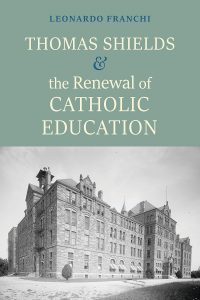 Franchi does the Catholic Church, and Catholic education in particular, a great service with this exemplary work of scholarship on the life, work, and intellectual heritage of Thomas Shields. His portrayal of Shields as a man of deep faith and great intellectual vision combined with practical action is compelling and inspiring; anyone with an interest in Catholic education would have something to learn from it.
Franchi does the Catholic Church, and Catholic education in particular, a great service with this exemplary work of scholarship on the life, work, and intellectual heritage of Thomas Shields. His portrayal of Shields as a man of deep faith and great intellectual vision combined with practical action is compelling and inspiring; anyone with an interest in Catholic education would have something to learn from it.
We are living through turbulent times, during which Catholic educators need role models, not just among the great saints whose lives and works offer well-trodden paths for us to follow, like St. Thomas Aquinas and St. John Bosco, but also among those who live in times more similar to ours. Thomas Shields is one such role model, a man whose life and work help illumine the nature and mission of Catholic education and the ways and means by which Catholic educators can rise to the challenges they face.
Franchi brings to life the full glory of Shields as a man whose ambition for Catholic education was of extraordinary proportions, all in the service of Christ. Shields was a greater man than most, and he lived in times of significant difference to ours, but he did battle with forces which we can recognize, and with which, to some extent, we are still battling today, albeit from a very different perspective. An excellent feature of Franchi’s work is the magisterial way in which he places Shields in his milieu, contending with, and learning from, the forces of Progressivism — notably the great philosopher of education Dewey — while also reforming Catholic education by challenging the stubborn, entrenched attitudes of many within the Catholic Church, a fortress defending herself at every turn from polluting influences such as Protestantism and Secularism.
A vital element of Shields’ genius was the intellectual vision with which he was able to build a bridge between the doctrine of the Catholic Church and Progressivism. His deep understanding of science, and his trust that good science is an expression of the glory of God, enabled him to see what was truly of merit in the progressive vision of education emerging in his lifetime and to find points of convergence whereupon the noble and true elements of that vision could be integrated with a genuinely Catholic vision of education, such as insights into the biological and psychological dynamics of learning and the sort of learning that is useful in real life.
However, for Shields, the relationship between Catholic doctrine and Progressivism was not a one-way street. When Shields recognized those elements of the Progressive movement which threatened the Catholic intellectual tradition, his response was to provide a robust scientific basis of defense against such threats. One of the great strengths of Franchi’s excellent book is to bring all this to light in such a way as to make it vitally relevant to Catholic education in the twenty-first century.
One of the many means by which Shields integrated progressive ideas with an authentic vision of Catholic education was his Gospel-centered pedagogical principles: 1. From the static to the dynamic, 2. Plasticity, 3. Adjustment, 4. Correlation, and 5. The relationship between mental development and mental growth. While these principles could sound too idealistic to be of use in the day-to-day life of school teaching, Shields recognized that it was not enough for him simply to propound such principles from an ivory tower; in the latter chapters of the book, Franchi explores the more practical aspects of Shields’ work, driven forward by his formidable energy, which gave teachers the support of practical resources alongside training and formation. Shields’ book The Teacher’s Manual of Primary Methods is but one of example of how he made his vision of Catholic education a practical reality.
Franchi portrays Shields’ Master Plan for Catholic education as among the most exalted of visions for Catholic educators in recent centuries. Shields pioneered new classroom methods and insisted on the absolute centrality of highly trained, professional Catholic teachers who were able to bring to bear the best of liberal education alongside vocational education, all in the service of their Catholic faith. These would be teachers whose understanding of Philosophy, Psychology, and History would enable them to reach into the hearts and minds of their pupils, meeting them where they were on their journey of faith, learning and life. Shields proposed three core principles for Catholic teacher training and formation: culture and vocation, correct methods and curriculum content.
In his conclusion, Franchi addresses some of the challenges and inconsistencies in Shields’ Master Plan of reform while also drawing attention to those aspects of it which offer vison and direction to everyone involved in contemporary Catholic education. Shields’ vision for Catholic education was exalted; it was full of holy ambition and courage; it was a vision for a time when the majority of Catholic schools were staffed by religious congregations with a charism for education. The world Catholic teachers work in today is not that world; the challenges we face are different; nevertheless, Shields is a man who can give us hope, courage, and vision. Franchi’s book is excellent, a breath of fresh air and the most inspiring book I have read about Catholic education in several years. I could not recommend it more highly.
Dr. Paul Bryant holds a PhD from St. Mary’s University in Twickenham (England) and presently serves as Head of Theology, Philosophy, and Religion at a preparatory school in Winchester (England).
Spiritual Masters – Alfred C. Hughes
Hughes, Archbishop Alfred C. Spiritual Masters: Living and Praying in the Catholic Tradition. San Francisco: Ignatius Press, 2024. 178 pages.
Reviewed by Robert P. Miller.
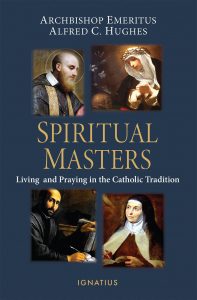 Spiritual Masters is a must-read for anyone interest in growing in the spiritual life. The key to growth is the manner in which one approaches the text, whether it be Scripture or some classical spiritual writer. The author states that when we read a text, “we have to bring a sense of wonder and awe . . . If we are going to be truly engaged in the experience.” Explaining further, he states, “we need to take off the student hat and put on the disciple hat.” In other words, the development of the interior life is not so much an intellectual pursuit that requires deep analysis, but rather something to which we must bring our “deeper selves to the effort.” As the author states, “the book is written for prayerful reading.” The author presents significant themes on advancing and dwelling in the spiritual life by drawing from Western spiritual classics.
Spiritual Masters is a must-read for anyone interest in growing in the spiritual life. The key to growth is the manner in which one approaches the text, whether it be Scripture or some classical spiritual writer. The author states that when we read a text, “we have to bring a sense of wonder and awe . . . If we are going to be truly engaged in the experience.” Explaining further, he states, “we need to take off the student hat and put on the disciple hat.” In other words, the development of the interior life is not so much an intellectual pursuit that requires deep analysis, but rather something to which we must bring our “deeper selves to the effort.” As the author states, “the book is written for prayerful reading.” The author presents significant themes on advancing and dwelling in the spiritual life by drawing from Western spiritual classics.
The book is logically arranged so as to guide our steps through the spiritual journey. It begins with the need for silence so that we may come to realize who we are, where we are going, and what has gone wrong in our lives. For these steps, Hughes draws from St. Anthony of the Desert, Walter Hilton, and St. Augustine. The next steps deal with the way in which we live, friendship and charity, a holy rhythm of life, and spiritual warfare. For these steps, Hughes integrates the works of Aelred of Rievaulx, St. Benedict, and Thomas à Kempis. Next, the author speaks about the necessity of prayer and the sacramental life as seen in the works of Guido the Carthusian, St. Teresa of Ávila, and St. Catherine of Siena. Finally, he deals with the way through life by virtue, discernment, suffering, and abandonment in the works of Francis de Sales, St. Ignatius, St. John of the Cross, and Jean-Pierre de Caussade.
Each chapter follows a pattern, beginning by placing each author within his or her own historical context, then discussing the relevant teachings of each spiritual master, and ending with implications for our own lives and a concluding prayer that relates the lesson of the chapter to the implications for our lives.
Every chapter is plentiful with spiritual insights, but the following serve as examples of the richness within these pages.
The chapter on St. Benedict and his rule is appropriately titled A Holy Rhythm of Life, since the motto of the Benedictine Order is ora et labora (pray and work) and is to be a constant reminder that each day is a gift and is not to be wasted, whether it be in prayer, work, social leisure, meals, physical exercise or other activities. Archbishop Hughes explains, “It is important for us to give explicit attention to the development of a way of life that encourages balance, depth, and clear direction.” This balance of daily living is taught in Benedict’s Rule, which begins with the virtue of obedience. For Benedict, “obedience was a condition for moving from a self-centered way of life to one that is truly open to God’s will.” The application for our lives is all-encompassing because in living the Benedictine model, we see that nothing need be purely secular. The most ordinary and mundane tasks of our daily life and work can be prayer if offered to God and done with the right intention.
The chapter on St. Catherine of Siena draws especially from her famous work The Dialogue. Hughes reminds us that it is only in solitude that “we have the opportunity to see God, ourselves, others, the world, and the demonic as they really are,” and that it is necessary to introduce the condition of solitude for authentic prayer. But what is especially important in this chapter is the connection between personal prayer and liturgical prayer. Christ revealed this relationship to Catherine in prayer with the words: “The body tastes only the flavor of bread, but the soul tastes me, God and human. So . . . the body’s senses can be deceived, but not the soul’s . . . And she [the soul] tastes it with her spiritual sense of holy desire, that is, she tastes the burning, unspeakable charity with which I have made her worthy to receive the tremendous mystery of this sacrament and its grace.”
Archbishop Hughes indicates that the implication for us is how we ourselves approach the liturgy. The holy desire that Christ revealed to St. Catherine must become our own practice. In order for the Church to be renewed, “the desire that we bring to become interiorly involved in the sacred mystery that is celebrated ultimately makes the difference.”
Spiritual Masters: Living and Praying in the Catholic Tradition is a spiritual treasure. It draws from some of the great spiritual classics and explains them in a most accessible way for any reader. I highly recommend it.
Dr. Robert Miller is an Associate Professor of Religious Studies at Mount St. Mary College, Newburgh, NY.
The Holiness of Ordinary People – Madeleine Delbrêl
Delbrêl, Madeleine. The Holiness of Ordinary People. Ed. by Gilles François and Bernard Pitaud. Trans. by Mary Dudro Gordon and Abigail Tardiff. San Francisco: Ignatius Press, 2024. 187 pages.
Reviewed by S.E. Greydanus.
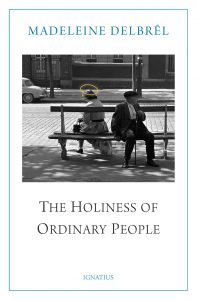 Venerable Madeleine Delbrêl (1904–1964) was certainly familiar with, and likely influenced by, the life and writings of her fellow Frenchwoman, Saint Thérèse of Lisieux, who died a mere seven years before Madeleine was born. In many respects they lived vastly different lives — the sheltered young girl who entered the cloister at fifteen and died just nine years later vs. the revert from atheism who devoted her life to serving the materially and spiritually poor — yet, on a deeper level, these two women of sensitive, creative natures and utterly wholehearted love had a good deal in common. Both recognized clearly, and emphasized strongly, that holiness is accessible to ordinary people in and by means of their ordinary lives. Both appreciated the power of prayer and suffering to spread grace throughout the world. Both were consumed with a missionary love for their straying brethren, lost amid a godless world; in different ways, both even experienced the wrenching emptiness of a life without God. Crucially, both also found fulfillment of their missionary urge in their own backyard.
Venerable Madeleine Delbrêl (1904–1964) was certainly familiar with, and likely influenced by, the life and writings of her fellow Frenchwoman, Saint Thérèse of Lisieux, who died a mere seven years before Madeleine was born. In many respects they lived vastly different lives — the sheltered young girl who entered the cloister at fifteen and died just nine years later vs. the revert from atheism who devoted her life to serving the materially and spiritually poor — yet, on a deeper level, these two women of sensitive, creative natures and utterly wholehearted love had a good deal in common. Both recognized clearly, and emphasized strongly, that holiness is accessible to ordinary people in and by means of their ordinary lives. Both appreciated the power of prayer and suffering to spread grace throughout the world. Both were consumed with a missionary love for their straying brethren, lost amid a godless world; in different ways, both even experienced the wrenching emptiness of a life without God. Crucially, both also found fulfillment of their missionary urge in their own backyard.
A prolific writer, Madeleine left a rich store of spiritual thought in her essays, which The Holiness of Ordinary People gathers and organizes. It presents her writing a bit differently from the reader reviewed last year, The Dazzling Light of God: Where the latter takes small excerpts from various works and presents them in daily-meditation format, the former is more in the style of a collection proper, an assortment of entire essays with brief introductions to each, placed more or less in chronological order of their writing.
The first, “We, the Ordinary People of the Streets,” develops the keynote theme indicated by the title of the collection. Understanding clearly the universal call to holiness, Madeleine explores in detail how, just as a monastery is the site of sanctity for cloistered religious, daily life in the world is the same for laypeople: “They love their door that opens onto the street, just as their brothers, who are hidden from the world, love the door that has definitively closed on them” (22).
The next chapter, “Our Daily Bread,” flows easily out of the preceding, reflecting on the given circumstances of our lives as part of our means to achieve holiness. These include elements often seen as burdens imposed on us: our body, our work, our pain. Madeleine gives particular attention to “daily pain” (a homophone in French for “daily bread”), insisting on the importance of “pain well done” for the world’s salvation: “The act of botching the way we handle our little bit of daily pain . . . is of more importance for the real history of the world than this disaster or that victory commented on by the voice coming over the airwaves” (40). Often, as here, her language is more severe than that of the Little Flower of Lisieux, yet expresses similar truths.
The missionary emphasis begins in force after this point. “Pagan Countries and Charity” is a brief set of notes, a little hard to follow, but clearly marked with the same sharp vision and uncompromising zeal found throughout the author’s work. The next installment, “Missionaries without Boats,” is easily the longest in the book (Madeleine called it a “small book” in itself), a fiery plea for Christians in their own countries to become missionaries amid a world grown pagan. The many ways in which this evangelization may be done, the many facets of society where witness to Christ is needed, are enumerated in great detail. Notably, Madeleine dedicated this text to St. Thérèse, patron of missionaries.
The remaining essays are shorter, their emphasis sometimes more contemplative, sometimes more evangelistic, but always with some presence of the one within the other; Madeleine had an unusually keen sense “that prayer is an action and that action is a prayer” (27). A common characteristic is the wakeup call, urging the faithful to rediscover what a powerful transformative influence God is meant to be for them. E.g.: “The only valid commentary on the Sermon on the Mount is our life, our lives in which those words fall like so many claps of thunder to shake us up and transform us” (120).
Like The Dazzling Light of God, The Holiness of Ordinary People provides brief biographical information on Delbrêl herself in the introductory pages, even briefer in this case. This book is not a place to begin to learn her life’s story, but a showcasing of her writing, recounting only as much about her as is necessary for context. On the other hand, one can appreciate the depth and beauty of the author’s reflections without a detailed knowledge of her life. To what extent one’s personal knowledge of Madeleine Delbrêl may enhance one’s appreciation of these writings, I am not in a position to say, having only just begun to learn about her myself. On the other hand, readers first encountering her here or bringing only minimal knowledge of her will likely come away, as I have, wanting to learn more about this extraordinary woman, who both belonged to her world and transcended it by a life even more eloquent than her writings.
S.E. Greydanus is a freelance writer/editor, a lay Dominican, and managing editor of Homiletic & Pastoral Review.
100 Tough Questions for Catholics – David Bonagura Jr.
Bonagura, David Jr. 100 Tough Questions for Catholics: Common Obstacles to Faith Today. Manchester, NH: Sophia Institute Press, 2025. 159 pages.
Reviewed by Daniel B. Gallagher.
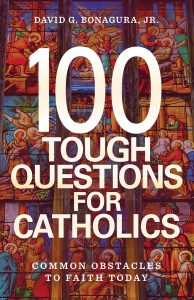 Busy pastors know better than anyone the importance of having a few titles to suggest at the drop of a hat. Just as often it’s an aunt or grandparent looking for that perfect high-school graduation gift. David Bonagura’s 100 Tough Questions should definitely be on their list.
Busy pastors know better than anyone the importance of having a few titles to suggest at the drop of a hat. Just as often it’s an aunt or grandparent looking for that perfect high-school graduation gift. David Bonagura’s 100 Tough Questions should definitely be on their list.
Some short-answer books are simply out of date, either because young people have evolved or the Church has clarified magisterial teaching on certain issues in the meantime. So, there’s always room for a fresh, up-to-date question-and-answer format in the Catholic book world. The challenge is to make it engaging, relevant, and persuasive, especially to young readers, who are Bonagura’s main audience.
Bonagura is perfectly positioned to write such a book. Teaching at both a first-rate seminary and a distinguished high school, Bonagura knows the questions that drive teens today and responds to them with rare theological refinement. Quite frankly, the most effective pastors — unless they are in the classroom every day — rather than trying to keep up with pop trends, delegate the heavy lifting of catechesis for young people to seasoned educators like Bonagura, who spends his entire day helping students tackle “the most repeated, pressing, and hot-button questions” about their Catholic faith (6).
It’s also a matter of knowing which questions to include. Hence Bonagura’s subtitle, “Common Obstacles to the Faith Today,” for the obstacles are not the same as they were thirty years ago. In the 1980s, for example, it was no less necessary to address the question “Why does the Church prohibit sex outside of marriage?” but not as crucial to discuss what the Church teaches about transgenderism. Today, given the prevalence of the latter, it may even be a more pressing question than the former.
Bonagura marvelously arranges the questions so that they can be consulted individually but also read in a continuous narrative. This is driven by his conviction that the questions themselves are not “one-offs” but “leaves” on a “branch” growing from “a wider trunk” firmly rooted in “the soil” of the deposit of faith (6). This organic whole underlies and holds together each of the fourteen chapters.
The book begins with fundamental questions regarding the human person, God, and divine revelation, situating them within the challenges of modern science. More specific questions about good and evil, morality, and sin are then presented before moving onto other religions, the salvific mission of Christ, and the Bible. He then delves into the sacraments, prayer, death, heaven, hell, and conversion. The breadth of topics covered in such a slim volume itself attests to the time and care Bonagura has taken in putting this book together.
A book of this type should also leave room for discussion within the classroom to refine distinctions that young people can then reflect upon as they grow older. Bonagura distinguishes, for example, between what we can know by natural law and what we know through faith (45). The question of how these two reinforce one another and overlap is complicated and academic, but Bonagura does not let those subtleties get in the way of a straightforward discussion of how we can know good and evil.
He also explores the question of good and evil exactly from the angles that young people inevitably approach it: e.g., “Why doesn’t God just eliminate evil?” and “Why does God allow people to suffer, even babies and children?” Too often, questions like this are belittled by teachers with advanced theological degrees when they enter a classroom of adolescents. Bonagura does justice not only to the fairness of such questions but their honesty and depth. For example, in response to the second question above, he writes, “Redemptive suffering is easy to speak about but terribly difficult to endure. It requires God’s help and repeated, concerted efforts on our parts to redirect our sufferings from looking in on ourselves to looking up toward God” (47). That seems the response of a man who not only has great sympathy for young people’s questions, but who has tried to make sense of redemptive suffering in his own life.
I highly recommend 100 Tough Questions to young and old alike. The care with which Bonagura has written and arranged it will make even those who know the answers to the questions already come up with more effective ways to formulate them for those who encounter them as obstacles.
Daniel B. Gallagher is a lecturer in philosophy and literature at Ralston College.
Come to Me – Sr. Anne Flanagan, FSP
Flanagan, FSP, Sr. Anne. Come To Me: Living the Nine First Fridays. Boston, MA: Pauline Books & Media, 2023. 272 pages.
Reviewed by Betty B. Bosarge, OSF.
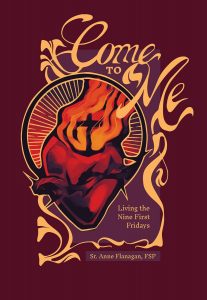 For priests and deacons who want to encourage fervent First Friday devotions among their parishioners, Come To Me: Living the Nine First Fridays is a perfect companion and guide.
For priests and deacons who want to encourage fervent First Friday devotions among their parishioners, Come To Me: Living the Nine First Fridays is a perfect companion and guide.
The author, Sister Anne Flanagan, a Daughter of St. Paul for over 40 years, put much prayer and hard work into writing this guidebook. Her own deep devotion to the Sacred Heart of Jesus shows forth in her writing, and it is easy to see that Sr. Flanagan practices what she preaches.
She writes for the average people in the pews, not for scholars, but the scholarly touch is there as she delves into Scripture, shows how various saints embraced the Sacred Heart, and illustrates how Jesus leads contrite and humble souls to come to Him for consolation.
The book is broken into nine chapters for the nine First Fridays, but begins with a chapter called “An Invitation,” in which Sr. Flanagan describes devotion to the Sacred Heart and its development over the centuries, the twelve Promises of the Sacred Heart, and how deeply Eucharistic this devotion is, which not only focuses on receiving Jesus in the Holy Eucharist but ties in reparation for sins.
Each First Friday chapter begins by showing readers how to enter into the Sacred Heart, followed by a time for reflection. Then comes a Witness Profile, focusing on various saints and how they lived the Sacred Heart devotion. This is accompanied by an hour of Eucharistic Adoration.
In the nine-month journey, Sr. Flanagan takes readers deep into the Sacred Heart, beginning with awakening our hearts, Kairos, a season of grace as we embrace the Sacred Heart.
Over the next eight months, readers will learn how to come to the Heart of Jesus with a grateful heart, a receptive heart, a heart ever new, a convicted heart, a heart that is poor in spirit, a heart set free, a confident heart, and an apostolic heart. It is a journey that leads sincere participants along that narrow road to Heaven.
Each chapter has a fascinating story about a saint or someone on the way to sainthood, showing how devotion to the Sacred Heart impacted and often changed their lives. There is Saint Josephine Bakhita, St. Ignatius Loyola, Saint Augustine, Blessed Pier Giorgio Frassati, Blessed Franz Jägerstatter, and St. Francis Xavier.
But there are some surprising profiles as well: Takashi Nagai, a convert who as a young doctor survived the atomic bombing of Nagasaki and went on to help save as many lives as he could; Caryll Houselander, a revert who wrote the Marian classic The Reed of God, and Chiara Corbella Petrillo, a millennial in Rome who had such trust in God that she chose to forgo cancer treatment while pregnant. A healthy son, Francesco, was born but she died a year later at age 28.
Sr. Flanagan shows how these three ordinary people embraced the Sacred Heart, totally trusting God, something we are all called to do.
This book is one that can be used in parishes to draw both teenagers and adults closer to Jesus, fostering in them a deep love for the Sacred Heart which will enrich their participation at Mass and reception of the Holy Eucharist.
It is a good text for an adult education class and the exercises and adoration guide at the end of each chapter will inspire lively discussions among participants. For teenagers, this book is excellent to introduce to those preparing for Confirmation, a two-year journey in most parishes. If teens absorb what Sr. Flanagan is teaching in this book and lose themselves in the Sacred Heart of Jesus as a result, this knowledge and abundance of grace will provide them with a good solid defense against the temptations to stop attending Mass when they are in college, in the military, or working.
The final chapter of the book, titled “Into the Deep,” summarizes what the participant discovered in the nine First Fridays. It also has a biography of St. Margaret Mary Alacoque. There is a final section with the Act of Consecration, the Enthronement of the Sacred Heart in the home, and other prayers and blessings.
This little book is a magnificent treasure for everyone who loves Jesus.
Dr. Betty Bosarge, OSF, is a retired criminologist who specialized in Traditional Organized Crime and police training. She serves as spiritual formation minister for Secular Franciscans in Austin, Texas.

Recent Comments